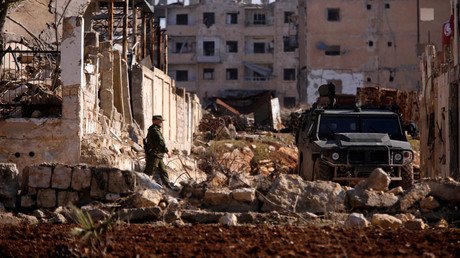Chemicals & gas cylinders in schools: RT follows bomb disposal units in eastern Aleppo (EXCLUSIVE)
The odd sight of gas cylinders, mortar shells, and the makings of deadly phosphine gas stored in a school classroom met an RT crew in Syria that joined bomb disposal units making recently liberated areas of eastern Aleppo safe for residents to return.
The Syrian army has finally gained the upper hand in the majority of Aleppo. Roughly half of the city has now been liberated from the terrorist and rebel groups that had been holding civilians as hostages there. As bomb disposal experts work to clear eastern Aleppo of strategically-placed and unexploded devices, the dust is clearing and a long-awaited sense of calm is finally settling in.
As of Sunday, more than 30 of Aleppo’s districts had been cleared of militants.
As the Syrian army ploughs through neighborhood after neighborhood, RT’s Lizzie Phelan joined the army and its bomb squads in the liberated areas that are now being made safe to live in again. One such neighborhood is Masaken Hanano, which was seized from rebel control last month and is already seeing its residents return by the hundred.
The extremely dangerous work doesn’t just involve dismantling bombs in plain sight. Aleppo is now an urban jungle, and the work of the engineers is as lethal as that of a soldier’s in the heat of battle.
Over the past five years, some 200 bomb disposal engineers have been reduced to just 16, the unit’s chief, Lieutenant Colonel Alaa Mehrez, told RT.
Explosives, remote detonators, and suicide belts abound in every facility that the rebels repurposed, including schools and hospitals. The area is rife with gas cylinders and mortar shells as well.
“If they were true revolutionaries, they would not have chosen to use this children’s building for these purposes,” he says.
In a school with textbooks littering the floors, one classroom houses a makeshift bomb-making factory, complete with instructions on working with aluminum phosphide and phosphine gas – an extremely toxic chemical that Islamic State (ISIS/ISIL) used against Kurdish forces in northern Syria last year.
Although Alaa and his overstretched team have been working around the clock, the strain is hardly noticeable in his mood.
“I like this job,” he says. “When you play with death, that’s the difference. Death is not the problem. The problem is home – to stay or not to stay.”
RT managed to film some locals returning with what few possessions they still had – the main thing the government wants to see after the siege is finally over.
All the while, thousands of miles away, the political process is ongoing, with Russia and the United States working to iron out the details of a rebel withdrawal – something Russian Foreign Minister Sergey Lavrov said will be concluded in the next few days.
“During the Russian-American consultations, concrete routes and the timing for the withdrawal of all militants from eastern Aleppo will be discussed. Once we reach an agreement, a ceasefire will be put in place,” he said, referring to a proposal put forth by US Secretary of State John Kerry. Negotiations, which were pushed forward from an earlier date at Washington’s request, are expected to finally begin on Tuesday after the two meet in Rome.
Lavrov also told journalists that Moscow would not be supporting a new UN Security Council resolution to secure yet another ceasefire in Aleppo for a simple reason:
“Taking into consideration the outcome of the previous pauses [in the conflict], there is absolutely no doubt that the 10-day ceasefire with which backers of the draft resolution generously want to provide the militants would surely be used for regrouping and rearming the extremists and slow down the liberation of eastern Aleppo from them,” he said.
The current UNSC draft initially called for a 10-day ceasefire, but that target has now been reduced to seven.
However, Russia believes that the resolution is counterproductive, insisting that the most surefire way to return life in the war-torn city to normal would be for the terrorists and rebel militants to hand over the areas they control to the Syrian government.













